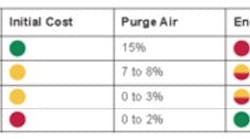Whether air is used for instrument calibration, pneumatic conveying, general shop use or manufacturing processes, effective compressed air drying has a significant impact on the quality and integrity of products and the tools used to make those products. The presence of liquid water or a high concentration of moisture vapor in compressed air can induce corrosion on internal surfaces, hinder flow, reduce the life of critical equipment and tools, and contaminate liquid or powder processes.
While much thought and calculation goes into the selection of an air compressor to ensure the necessary volume of air is generated for a compressed air system, selecting the proper dryer will also have a significant impact on the quality of the air that is ultimately delivered to downstream processes.
Drying compressed air
Air dryers remove moisture before it can contaminate the system and other parts of a manufacturing process. Different types of dryers yield different dew-point ranges (or humidity levels). It is important to identify the necessary dew point for the system to ensure the integrity of downstream processes. Once the minimum required dew point is determined, plant managers can determine which dryer they should use for a particular application.
Compressed air dryer types
- Refrigerated dryers: For applications that require a dew point between 38 degrees Fahrenheit and 50 degrees Fahrenheit, refrigerated dryers provide appropriate drying for a comparatively low acquisition cost and low cost of operation. Refrigerated dryers dry compressed air by reducing the air temperature, exchanging heat from the compressed air with that of a cold medium. As the temperature is reduced, moisture condenses out of the air stream. This moisture is then collected in a moisture separator within the dryer and discharged from the system via a dedicated drain valve.
- Desiccant dryers: For applications requiring extremely dry air, desiccant dryers can be used to provide air with average pressure dew points well below freezing, typically ranging from -40 degrees Fahrenheit to -100 degrees Fahrenheit. Most desiccant dryers have a twin tower design, and each tower is filled with a desiccant material in bead form that adsorbs moisture. As the air passes through the dry desiccant media, moisture is adsorbed by the media, thereby drying the air. For these dryers, one tower acts as the drying tower while the desiccant beads in the other tower are regenerated. Using a time-based or demand-based sequence, the towers alternate between drying and regenerating to deliver a continuous supply of dry air.
- Heat-of-compression dryers: For applications that use oil-free compressors, another type of twin-tower desiccant dryer, heat-of-compression (HOC) dryers, can be used. In these applications, the aftercooler on the air compressor is bypassed, resulting in particularly hot air at the compressor outlet. In HOC dryers, this hot compressed air, typically between 300 and 340 degrees Fahrenheit, enters the dryer from the compressor and is directed to the regeneration tower. As air flows through this tower, heat drives moisture from the desiccant media, carrying it to an aftercooler and moisture separator where the air temperature is reduced and moisture in the compressed air condenses. Condensed moisture is discharged from the separator via a drain valve. The air then flows into the drying tower, where desiccant media adsorbs moisture from the compressed air. The air exits the drying tower with a pressure dew point similar to that of desiccant dryers.
Although dew-point performance of these dryers depends on inlet air conditions and volume more so than with other desiccant technologies, HOC dryers can be an extremely energy-efficient option because they make use of the heat that is usually extracted from the compressed air system.
Identifying the process and ambient conditions, recognizing the degree of dry air required, and knowing the characteristics of the various drying methods is essential in designing the overall compressed air system for manufacturing facilities. Armed with this information, you can specify the appropriate compressed air dryer that meets your facility's performance requirements.
For more information about dryer options for your compressed air system, visit www.ingersollrandproducts.com.
Different types of desiccant dryers and decision criteria:
Chad Larrabee is director of services marketing in North America for the air business of Ingersoll Rand. He is responsible for all parts and service offerings, including the advanced services of system assessments for optimization and removing waste in compressed air systems. Larrabee has 23 years in the compressed air industry and currently serves as education committee chairman for the Compressed Air and Gas Institute.
